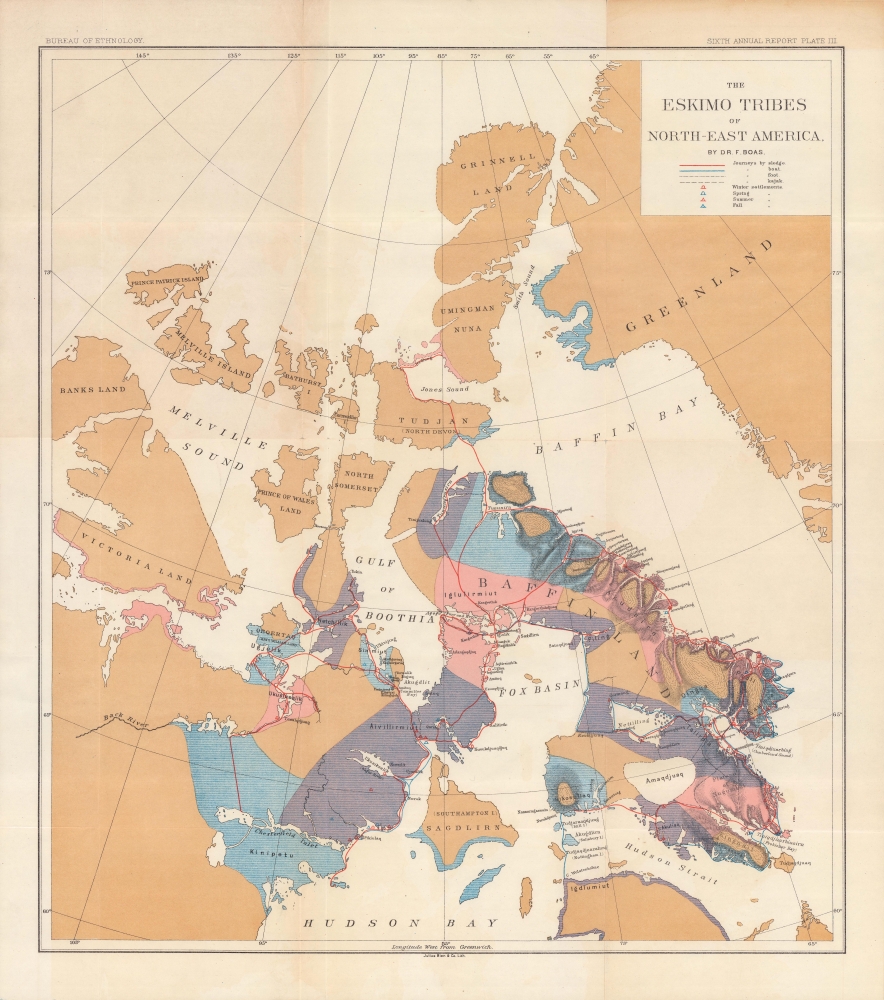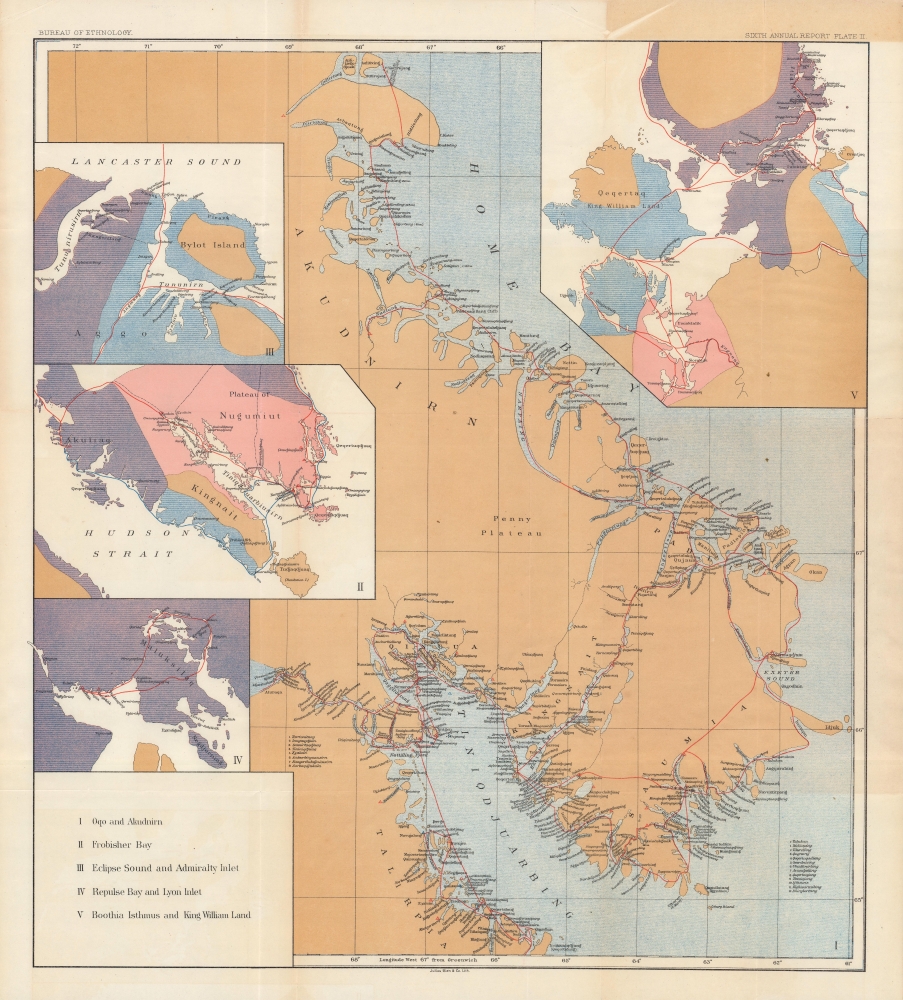This item has been sold, but you can get on the Waitlist to be notified if another example becomes available, or purchase a digital scan.
1885 Franz Boas Ethnographic Map of Arctic Indigenous Tribes
EskimoTribes-boas-1885
Title
1885 (undated) 19.5 x 17.5 in (49.53 x 44.45 cm) 1 : 10300000
Description
A Closer Look
The first map provides a broad overview, covering territory that mostly falls within today's Nunavut, along with portions of Greenland. The second sheet includes five maps, a larger one focusing on the region in the southeastern portion of the first map around Tiniqdjuarbing, while the remainder similarly offer a smaller-scale representation of other regions important for indigenous settlement and migration, such as around Bylot Island and Iqaluit (Frobisher Bay).On both sheets, seasonal settlements are noted and paths of seasonal migration by various means are indicated. Color shading is used to distinguish between lands of various tribes, whose names are recorded in black text, though Boas himself reports considerable intermingling among these tribes across the 'borders' suggested here. Boas employs indigenous terminology for many placenames, sometimes alongside English colonial terms, as with 'Tiniqdjuarbing (Cumberland Sound)' on the first sheet.
These maps accompanied Boas' article 'The Central Eskimo,' in effect a book in its own right, stretching to 271 pages. The comprehensive work covered the linguistic, economic, social, religious, scientific, and artistic aspects of the cultures studied (Boas mentions in his introduction that the Bureau considered a portion of the text 'unsuitable for publication,' perhaps a reference to research on sexuality). Notable among his classification of indigenous cultures is a section on geography and navigation, where several remarkably detailed maps of coastlines drawn by indigenous people are reproduced.
Publication History and Census
These maps were prepared by Franz Boas and lithographed by Julius Bien and Company. They appeared in the Sixth Annual Report of the Bureau of Ethnology to the Secretary of the Smithsonian Institution, 1884-1885, published in 1888 by the Government Printing Office, to accompany Boas' article 'The Central Eskimo.' They are independently cataloged among the holdings of the University of California Santa Barbara, the University of Minnesota Twin Cities, the University of Chicago, Pennsylvania State University, the University of Southern Maine, the Buffalo and Erie County Public Library, McGill University, and Western University.CartographerS
Franz Boas (July 9, 1858 – December 21, 1942) was a German-born ethnographer who was deeply influential on the development of anthropological research, especially in the United States. Born in Minden, Westphalia, Boas studied physics and geography at several German universities. On the advice of his advisor, geographer Theobald Fischer, Boas traveled in 1883 to Baffin Island to study indigenous cultures, sparking an interest in the peoples of the Artic and Subarctic that would lead him to return to the region several times in subsequent years. In 1887, Boas journeyed to the Pacific Northwest of the United States to research Native American peoples. Due to limited opportunities in Germany and concerns over growing antisemitism (his grandparents were secularized Jews), Boas decided to stay in the U.S. After taking a position for several years at Clark University, where he repeatedly clashed with university president G. Stanley Hall, Boas was selected by Frederic Ward Putnam, director and curator of the Peabody Museum at Harvard University, to prepare ethnographic exhibits for the 1893 World's Columbian Exposition in Chicago. Afterwards, he helped to establish the Field Museum in Chicago and then went to work for the American Museum of Natural History in New York City. Boas was a pioneer in understanding cultures on their own terms and in their proper context, making him one of the formulators of cultural relativism. He was continually frustrated by both fellow scholars and the wider public in their portrayal of indigenous cultures as 'savage' and insisted that the differences between cultures were the product of particular physical and historical conditions rather than the relative 'advancement' or 'superiority' of one culture versus another. More by this mapmaker...
Julius (Julien) Bien (September 27, 1826 - December 21, 1909) was a German-Jewish lithographer and engraver based in New York City. Bien was born in Naumburg, Germany. He was educated at the Academy of Fine Arts, Cassell and at Städel's Institute, Frankfurt-am-Main. Following the suppression of the anti-autocratic German Revolutions of 1848, Bien, who participated in the pan-German movement, found himself out of favor in his home country and joined the mass German immigration to the United States. Bien can be found in New York as early as 1849. He established the New York Lithographing, Engraving & Printing Company in New York that focused on the emergent chromo-lithograph process - a method of printing color using lithographic plates. His work drew the attention of the U.S. Government Printing Office which contracted him to produce countless government maps and surveys, including the Pacific Railroad Surveys, the census, numerous coast surveys, and various maps relating to the American Civil War. Bien also issued several atlases both privately and in conjunction with a relation, Joseph Bien. At the height of his career Bien was elected president of the American Lithographers Association. After his death in 1909, Bien's firm was taken over by his son who promptly ran it into insolvency. The firm was sold to Sheldon Franklin, who, as part of the deal, retained the right to publish under the Julius Bien imprint. In addition to his work as a printer, Bien was active in the New York German Jewish community. He was director of the New York Hebrew Technical Institute, the New York Hebrew Orphan Asylum, and president of the B'nai B'rith Order. Learn More...




